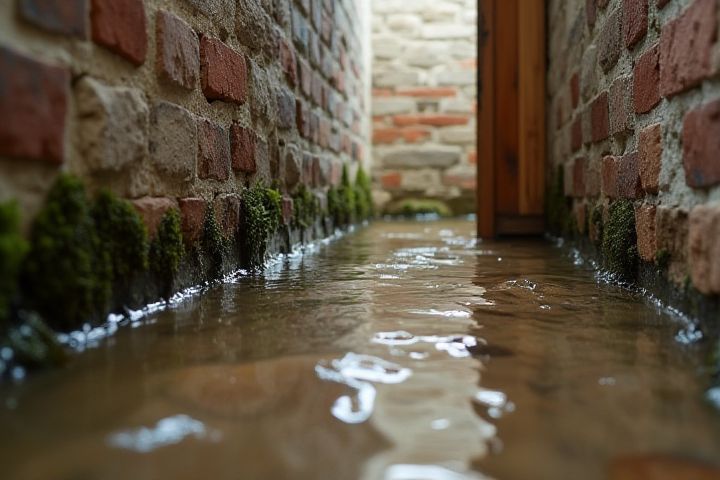
House basements flood due to various factors, primarily including poor drainage systems, excessive rainfall, and groundwater saturation. Inadequate or clogged gutters and downspouts can lead to water pooling near the foundation, increasing the risk of water seeping into your basement. Improper grading of the landscape can also redirect rainwater toward the home, contributing to flooding issues. Furthermore, cracks in your basement walls or floors can allow water intrusion, especially during heavy storms. Finally, high water tables during wet seasons can elevate groundwater levels, causing water to flow into basements from underground sources.
Why House Basements Flood
Poor Drainage
Poor drainage is a primary cause of house basement flooding, often resulting from inadequate or blocked drainage systems. When rainwater or melting snow accumulates around the foundation, it can overwhelm gutters, downspouts, and drainage ditches, allowing water to seep into the basement. Additionally, compacted soil or landscaping that directs water toward the home can exacerbate the issue, leading to significant damage and costly repairs. Regular maintenance of drainage systems, including clearing debris and ensuring proper grading around your property, is essential to safeguard against basement flooding.
High Water Table
A high water table significantly increases the risk of basement flooding, as it denotes the level below which soil is saturated with water. In areas where the water table is within a few feet of the surface, heavy rainfall or rapid snowmelt can overwhelm drainage systems, causing water to seep into your basement. Studies show that homes in regions with a high water table can experience flooding rates of up to 30%, particularly during wet seasonal cycles. To mitigate this risk, homeowners should consider installing sump pumps or drainage systems to manage excess water and protect their property effectively.
Faulty Sump Pump
A faulty sump pump is a primary contributor to basement flooding, as it is designed to remove excess water from below your home. If the sump pump fails due to mechanical issues or power outages, water can accumulate, leading to potential flooding. Regular maintenance of your sump pump, including checking for clogs and ensuring it is properly connected to a power source, can help mitigate these risks. Investing in a backup sump pump system can provide added protection, ensuring that your basement remains dry even during heavy rain or pump failure.
Cracks in Foundation
Cracks in the foundation are one of the primary causes of basement flooding, often leading to significant water damage and costly repairs. Structural issues, such as settling or shifting soil, can create fissures that allow groundwater to seep in. Foundation cracks can range in size from hairline to several inches wide, making it crucial to inspect them regularly. To mitigate this risk, you should consider waterproofing solutions and regular maintenance to protect your home's foundation from moisture intrusion.
Improper Grading
Improper grading around your home can lead to basement flooding by directing rainwater and melting snow toward the foundation instead of away from it. When the land surrounding your house slopes inward, water accumulates near the base, increasing the likelihood of seepage through cracks or porous materials. This excess water pressure can overwhelm any drainage systems you may have in place, causing water to enter your basement. Ensuring that the grading is properly sloped and maintained can significantly reduce the risk of water intrusion and protect your home from potential damage.
Clogged Gutters
Clogged gutters can lead to significant water accumulation around the foundation of your house, increasing the risk of basement flooding. When rainwater overflows from blocked gutters, it may seep into the ground, saturating the soil and creating hydrostatic pressure against the basement walls. This water pressure can force moisture through cracks and vulnerable areas, resulting in leaks and flooding. Proper gutter maintenance, including regular cleaning and inspection, is essential to direct water away from your home and protect your basement from water damage.
Heavy Rainfall
Heavy rainfall can overwhelm drainage systems and saturate the ground, leading to flooding in house basements. When the soil becomes fully saturated, it loses its ability to absorb additional water, causing excess moisture to seep into basements through cracks and porous materials. Poor grading around the home can exacerbate the issue by directing water toward the foundation rather than away from it. Ensuring proper drainage systems, like sump pumps and French drains, is crucial to mitigating the risk of basement flooding during intense rain events.
Sewer Backup
Sewer backup is a leading cause of basement flooding, particularly in urban areas where infrastructure can be strained during heavy rainfall or snowmelt. This occurs when the sewage system cannot handle excess water, causing wastewater to flow back into your home. In fact, the EPA estimates that over 5 million U.S. households experience some form of basement flooding each year, with sewer backup accounting for a significant portion of these incidents. To protect your basement, consider installing a backwater valve or regularly maintaining your sewer lines, which can dramatically reduce the risk of costly flood damage.
Hydrostatic Pressure
House basements often flood due to hydrostatic pressure, which builds when water accumulates around your foundation. This pressure pushes moisture through cracks, porosity in materials, or hydraulic lift in the soil, leading to seepage and potential damage. Poor drainage systems, such as clogged gutters or ineffective downspouts, can exacerbate this issue by directing water toward your basement walls. Understanding how hydrostatic pressure operates allows you to take preventive measures, such as improving drainage and sealing foundation cracks to protect your home from water intrusion.
Broken Pipes
Broken pipes are a leading cause of house basement flooding, often resulting in significant water damage and costly repairs. A staggering 10% of homeowners experience some form of flooding due to plumbing failures, with broken pipes accounting for a considerable portion. Over time, wear and tear, freezing temperatures, or high water pressure can compromise pipe integrity, leading to leaks that rapidly escalate into flooding. Regular inspection and maintenance of your plumbing system can prevent these issues and help protect your basement from potentially devastating water intrusion.
